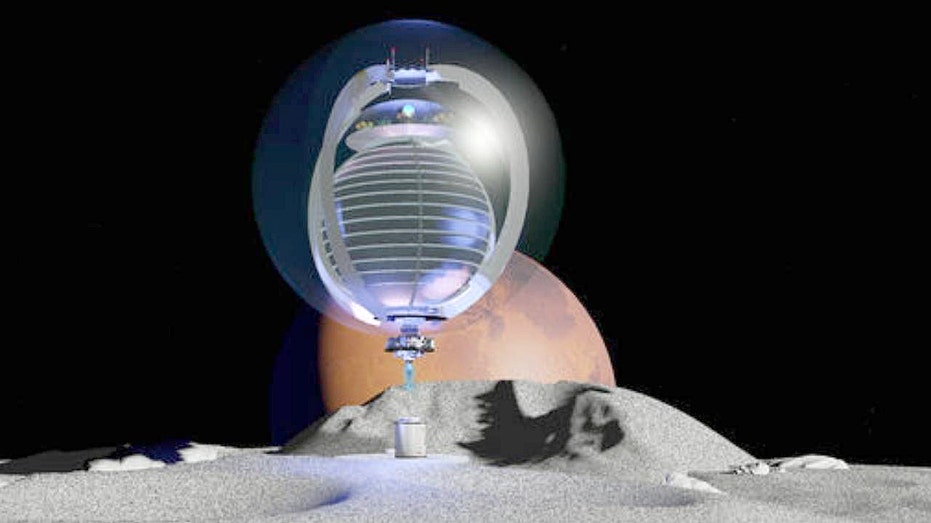Science
NASA and Skyeports Plan Glass Cities on the Moon for Astronauts

NASA is collaborating with Skyeports, a California-based company, to develop futuristic habitats on the Moon made from lunar dust. This innovative project aims to transform regolith, the fine dust covering the lunar surface, into large glass spheres that could provide living and working spaces for astronauts. If successful, these habitats may pave the way for sustainable human presence on the Moon.
Transforming Lunar Dust into Glass Habitats
Skyeports has devised a process to melt lunar regolith using microwave furnaces, ultimately creating durable glass. As the regolith melts, it expands like a bubble before cooling into a solid, transparent shell. These glass spheres are engineered to withstand the harsh conditions of the lunar environment, including micrometeorite impacts and extreme temperatures.
One of the key advantages of this approach is the use of local materials to build habitats. Transportation costs from Earth can be prohibitively expensive, but by utilizing materials readily available on the Moon, Skyeports aims to minimize those costs. The same pipes used to form the molten glass will also serve as entrances to these habitats, while 3D printers within the spheres can create furniture and fittings from lunar materials.
The design of the glass spheres is not merely aesthetic; their spherical shape allows for an even distribution of pressure, enhancing their structural integrity. The incorporation of elements like titanium, magnesium, and calcium will further strengthen the glass, making it tougher than steel.
Self-Sustaining Ecosystems for Lunar Living
The envisioned glass habitats will serve as more than just shelters. They are designed as self-sustaining ecosystems capable of supporting human life. Each sphere will feature self-healing properties, allowing them to automatically repair minor cracks caused by external forces. Built-in solar panels will generate energy, while temperature regulation systems will create condensation to support plant growth, producing oxygen and water.
Dr. Martin Bermudez, CEO of Skyeports, notes that current prototypes measure only a few inches in diameter, but the ultimate goal is to create spheres that could reach up to 1,640 feet across. He envisions a network of interconnected glass cities on the Moon, linked by transparent bridges to facilitate movement and communication.
The research and development efforts are supported by NASA’s Innovative Advanced Concepts program. This initiative funds innovative projects aimed at preparing for long-term human habitation on the Moon as part of the Artemis mission, which seeks to return humans to lunar soil in the near future.
Testing of the glass sphere concept is set to begin with experiments in a thermal vacuum chamber, simulating lunar conditions. Future trials will take place aboard the International Space Station, assessing the glassblowing technique in microgravity. If these tests prove successful, actual trials on the lunar surface could be conducted within the next few years.
This initiative not only represents significant advancements in space exploration but also has broader implications for sustainable architecture on Earth. The techniques developed for creating lunar habitats could inspire new approaches to building eco-friendly, energy-efficient structures back home.
As humanity moves closer to living and working on the Moon, the partnership between NASA and Skyeports marks a pivotal step in transforming science fiction into reality. The potential for glass cities on the lunar surface could redefine our understanding of sustainable living, both on the Moon and Earth.
-

 Politics1 week ago
Politics1 week agoDallin H. Oaks Assumes Leadership of Latter-day Saints Church
-

 Sports1 week ago
Sports1 week agoSteve Kerr Supports Jonathan Kuminga After Ejection in Preseason Game
-

 Lifestyle1 week ago
Lifestyle1 week agoDua Lipa Celebrates Passing GCSE Spanish During World Tour
-

 Business1 week ago
Business1 week agoTyler Technologies Set to Reveal Q3 2025 Earnings on October 22
-

 Entertainment1 week ago
Entertainment1 week agoZoe Saldana Advocates for James Cameron’s Avatar Documentary
-

 World1 week ago
World1 week agoD’Angelo, Iconic R&B Singer, Dies at 51 After Cancer Battle
-

 Science1 week ago
Science1 week agoChicago’s Viral ‘Rat Hole’ Likely Created by Squirrel, Study Reveals
-

 Lifestyle1 week ago
Lifestyle1 week agoKelsea Ballerini Launches ‘Burn the Baggage’ Candle with Ranger Station
-

 Health1 week ago
Health1 week agoRichard Feldman Urges Ban on Menthol in Cigarettes and Vapes
-

 Health1 week ago
Health1 week agoCommunity Unites for Seventh Annual Mental Health Awareness Walk
-

 Business1 week ago
Business1 week agoMega Millions Jackpot Reaches $600 Million Ahead of Drawings
-

 Business1 week ago
Business1 week agoMLB Qualifying Offer Jumps to $22.02 Million for 2024









